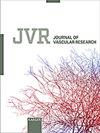In vivo Evidence of Arterial Dynamic Properties Alteration in Atherosclerotic Rabbit
IF 1.8
4区 医学
Q3 PERIPHERAL VASCULAR DISEASE
引用次数: 0
Abstract
Objectives: Atherosclerosis severely damages the arterial wall. The aim of this study was to assess in vivo, for the first time, arterial dynamic properties, reactivity, and stiffness in atherosclerotic (ATH) rabbits. Methods: The rabbits were fed with 0.3% cholesterol diet. Femoral artery (FA) or abdominal aorta (AA) diameter was recorded by echotracking, together with blood pressure. Arterial reactivity after local administration of agents and stiffness were measured as diameter or pulsatile diameter changes. Results: FA dilation induced by acetylcholine was reduced in the function of diet duration (9–65 weeks). With mid-term diet duration (35–45 weeks), the dilation to nitroprusside was greatly reduced; the constriction to norepinephrine was reduced but not that to serotonin, thromboxane agonist, or angiotensin II. After 17- and 28-week diet AA and FA stiffness were increased while distensibility was reduced. Arterial stiffness measured by regional pulse wave velocity was unaltered. We observed that after 28-week diet, FA exhibited a stiffened wall at the plaque level and higher distensibility at the upstream site. Discussion/Conclusion: Arterial reactivity and compliance were greatly modified by atherosclerosis, at various degrees dependent on diet duration. ATH rabbit is therefore a suitable model for in vivo investigations of treatments targeting dynamic properties of arterial wall.动脉粥样硬化兔动脉动态特性改变的体内证据
目的:动脉粥样硬化严重损害动脉壁。本研究的目的是首次在体内评估动脉粥样硬化(ATH)兔的动脉动力学特性、反应性和硬度。方法:家兔采用0.3%胆固醇饮食。通过回声追踪记录股动脉(FA)或腹主动脉(AA)的直径以及血压。局部给药后的动脉反应性和硬度测量为直径或脉动直径变化。结果:乙酰胆碱诱导的FA扩张在饮食持续时间(9-65周)的功能中减少。随着中期饮食持续时间(35-45周),对硝普钠的扩张作用大大减少;去甲肾上腺素的收缩减少,但血清素、血栓素激动剂或血管紧张素II的收缩没有减少。在17和28周的饮食后,AA和FA硬度增加,而膨胀性降低。通过区域脉搏波速度测量的动脉硬度没有变化。我们观察到,在28周的饮食后,FA在斑块水平上表现出变硬的壁,在上游部位表现出更高的膨胀性。讨论/结论:动脉粥样硬化极大地改变了动脉反应性和顺应性,在不同程度上取决于饮食持续时间。因此,ATH兔是针对动脉壁动态特性进行体内治疗研究的合适模型。
本文章由计算机程序翻译,如有差异,请以英文原文为准。
求助全文
约1分钟内获得全文
求助全文
来源期刊

Journal of Vascular Research
医学-生理学
CiteScore
3.40
自引率
0.00%
发文量
25
审稿时长
>12 weeks
期刊介绍:
The ''Journal of Vascular Research'' publishes original articles and reviews of scientific excellence in vascular and microvascular biology, physiology and pathophysiology. The scope of the journal covers a broad spectrum of vascular and lymphatic research, including vascular structure, vascular function, haemodynamics, mechanics, cell signalling, intercellular communication, growth and differentiation. JVR''s ''Vascular Update'' series regularly presents state-of-the-art reviews on hot topics in vascular biology. Manuscript processing times are, consistent with stringent review, kept as short as possible due to electronic submission. All articles are published online first, ensuring rapid publication. The ''Journal of Vascular Research'' is the official journal of the European Society for Microcirculation. A biennial prize is awarded to the authors of the best paper published in the journal over the previous two years, thus encouraging young scientists working in the exciting field of vascular biology to publish their findings.
 求助内容:
求助内容: 应助结果提醒方式:
应助结果提醒方式:


